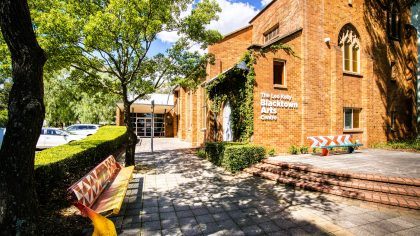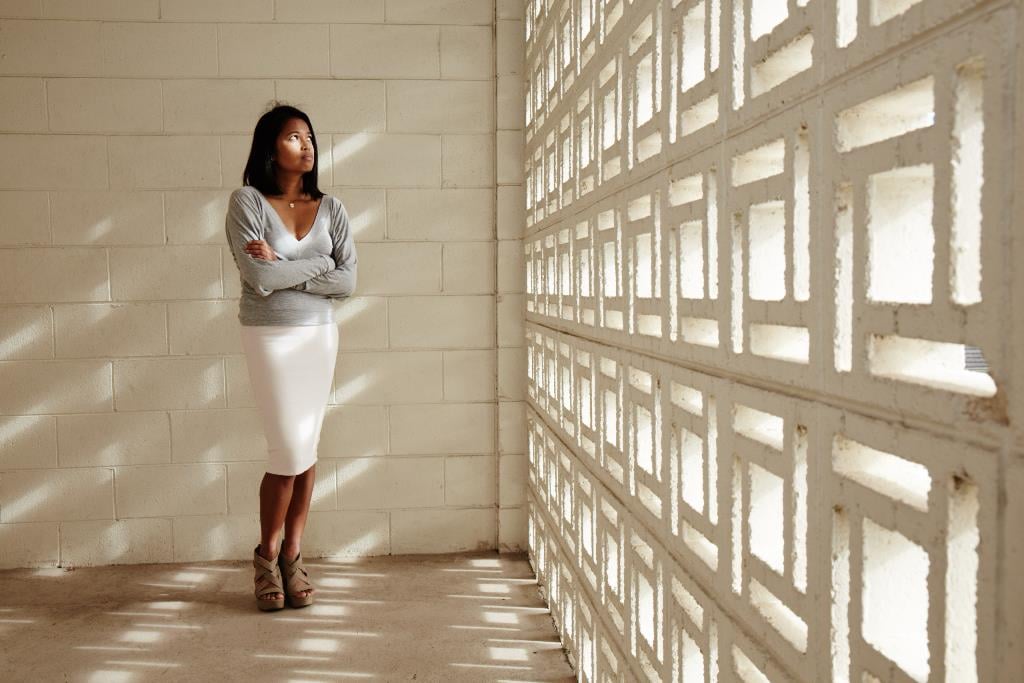
The Leo Kelly Blacktown Arts Centre
An innovative multi-arts hub in the heart of Blacktown City.
Bayadyinyang budyari Dharug yiyura Dharug Ngurra.
Bayady’u budyari Dharug Warunggadgu baranyiin barribugu.
Bayady’u budyari wagulgu yiyuragu Ngurra bimalgu Blacktown City. Flannel flowers dyurali bulbuwul.
Yanmannyang mudayi Dharug Ngurrawa. Walama ngyini budbud dali Dharug Ngurra Dharug yiyura baranyiin barribugu.
We acknowledge the Traditional Custodians of this Land, the Dharug people, and their continued connection to Country.
We pay our respects to Elders from yesterday to tomorrow.
We extend that respect to all Aboriginal and Torres Strait Islander Peoples of Blacktown City where the flannel flowers still grow proud and strong.
We will walk softly on this land and open our hearts to Country as the Dharug people have for tens of thousands of years.
Credit to: Dharug woman Rhiannon Wright, daughter of Leanne ‘Mulgo’ Watson Redpath and granddaughter of Aunty Edna Watson

Just before sunset, the artist Marikit Santiago was wandering around the Blacktown Arts Centre, casual in t-shirt and shorts, cheerily explaining her collection of paintings, some of which are quite dark.
The Son of a Whore depicts the President of the Philippines, Rodrigo Duterte, giving the middle finger but doing so in a quasi-religious manner, his head framed by a white halo and his body clad in a robe. The painting’s title is a quote from Duterte, who in the lead-up to a meeting with United States President Barack Obama said: “Son of a whore, I will curse you in that forum.” Next to him is a painting of Imelda Marcos, the widow of dictator President Ferdinand Marcos.
Santiago never considered herself as having political views but they seem to “slip out” in her work. “Right now, the political climate is quite volatile so I can’t help but criticise it,” she says.
The artist’s work is appearing in Balik Bayan, a new exhibition of Filipino art presented by Blacktown Arts, which literally translates to return to country. The phrase is also a play on the name of the big present-filled boxes that Filipinos living abroad send home to family and friends.
It’s opening night and Santiago’s parents have catered for the event, making spring rolls, marinated BBQ skewers and halo-halo, a desert of shaved ice, evaporated milk, boiled sweet beans, sago and fruit. Born in Sydney, Santiago was raised in a Filipino household but by the time she went to school and was exposed to different cultures, she had a sense of how set apart she was from her peers.
“I didn’t like that I was the only kid in my class with brown skin. I was really embarrassed by my name because it’s not easy to pronounce or spell. I wished I had blonde hair and blue eyes and white skin and a normal name like Melanie,” she says. “Now, I’ve learned to accept that my name is Marikit, I’m Filipina, that I have brown skin and black hair. I’ve learned to recognise the wealth in that ethnicity.”
While the title of the show would imply that it’s about mass Filipino migration – after all, the country has one of the world’s largest diasporas – Balik Bayan actually sketches out a Filipino universe. The rosary beads, the tins of Spam, the toy guns, the pregnant bodies, the bones in jars and an image of a horizon line reveal a Catholic, playful, macho, violent, maternal, mystical and island culture.
Outside the gallery sits Leeroy New, fresh from a flight from Manila. A tattoo-laden visual artist, he has in recent years branched into production design for film, theatre and installation. As a large steel frame looms in the centre’s car park, New explains that he is in the beginning phase of “fiesta making”, a Filipino tradition where streets and houses are literally dressed up for a party. But instead of using palm leaves and string, he’ll be using barbed wire and straps for his large sculptural work.
“There’s injected violence into this version of the fiesta,” he says, in reference to the current reign of terror in the Philippines, in which according to Human Rights Watch, an estimated 7,000 people have been killed for being alleged drug dealers and users.
“It’s become pretty grim,” he says. “It has taken a very dark turn.”
New says that while the majority of Filipinos are choosing to ignore the violence, he and many of his fellow artists in the Philippines have abandoned their traditional practice and are focused on the murders.
“You can choose to pretend nothing is happening but it’s not a choice for us. I have photojournalist friends who actually do the night shift and they wait in the police stations and wait for the call when the body is found. I’ve been seeing these images first-hand from my friends,” he says.
“One time, one of my friends, asked me to drive a kid who got shot in the leg to the hospital. His dad was the target and got killed. The kid got shot accidentally,” says New.
“These people are from the really poor communities. It’s strategic to target these groups because they have no means to defend themselves. They don’t have connections, they don’t have lawyers, they can’t afford lawyers. Everyone has to choose to be closer to these communities and be involved and give them a voice.”
Back inside is Bayanihan Hopping Spirit House, a large wooden house filled with objects: shells, cans, crucifixes, the jars of bones and plastic jeepneys. Created by Alwin Reamillo, it is based on the traditional Filipino practice of the bayanihan.
“In the old days, when a family in rural areas would like to relocate, they would call for the community to help literally lift the house on their shoulders using bamboo poles,” he explains.
While urbanisation has stopped the practice, Reamillo has creatively bought it back to life. First built in 2015, as part of Urban Theatre Projects’ BANKSTOWN: LIVE, the Hopping House has moved to various locations around Sydney.
As Reamillo talks, there is the pretty tinkle of chimes, some of which were made by students at Plumpton Senior High school.
While the “hopping” is a reference to migration, he says the spirit context is more secular. “You are calling the spirit of the community, you are also calling the spirit of creativity, of resourcefulness, all the positive things you can draw from Filipino culture, the sociability of Filipino culture.”
Reamillo himself lives in a state “in-betweenness”. He migrated to Perth in 1995 but four years ago moved back to Manila to care for his elderly mother. He now divides his time between Manila and Sydney.
“When I’m in the Philippines, I miss Australia. When I’m in Australia, I miss the Philippines …. You question home and what home is,” he says.
Like his work, Reamillo sees the Philippines as in a state of flux. “I think compared to most South East Asian countries, the Philippines hasn’t reached a highly developed organisational structure politically. We don’t have a monarchy. The Philippines became the Philippines because of colonisation. The name itself is referencing Philip II. We’re still in the process of making.”
This project has been assisted by the Australian Government through the Australia Council for the Arts, its arts funding and advisory body.
Balik Bayan
Blacktown Arts Centre
Until 2 November 2017